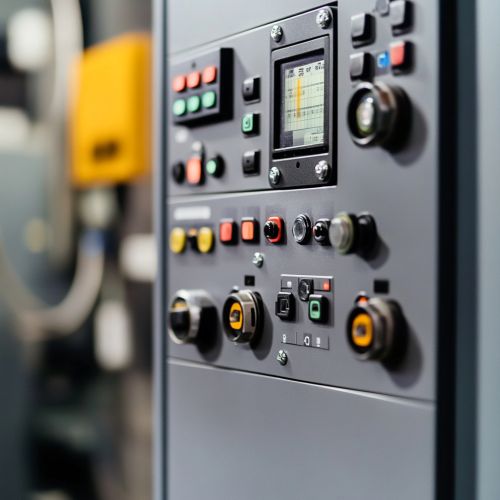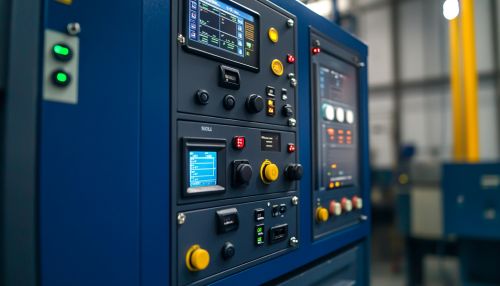Instruction List: Difference between revisions
(Created page with "== Overview == The '''Instruction List''' (IL) is a low-level programming language used primarily in Programmable Logic Controllers (PLCs). It is part of the IEC 61131-3 standard, which defines programming languages for PLCs. IL is designed to be simple and efficient, allowing for direct manipulation of hardware and execution of control algorithms. It is similar in style to assembly language, providing a set of instructions that operat...") |
No edit summary |
||
| Line 84: | Line 84: | ||
While Instruction List remains a popular choice for certain applications, the trend in industrial automation is towards higher-level languages that offer greater abstraction and ease of use. As PLCs become more powerful and capable, languages like Structured Text and Function Block Diagram are becoming more common. However, IL is likely to remain relevant for applications where efficiency and direct hardware control are paramount. | While Instruction List remains a popular choice for certain applications, the trend in industrial automation is towards higher-level languages that offer greater abstraction and ease of use. As PLCs become more powerful and capable, languages like Structured Text and Function Block Diagram are becoming more common. However, IL is likely to remain relevant for applications where efficiency and direct hardware control are paramount. | ||
[[Image:Detail-98331.jpg|thumb|center|An industrial control panel with various buttons, switches, and displays, representing the application of Instruction List in automation.|class=only_on_mobile]] | |||
[[Image:Detail-98332.jpg|thumb|center|An industrial control panel with various buttons, switches, and displays, representing the application of Instruction List in automation.|class=only_on_desktop]] | |||
== See Also == | == See Also == | ||
Latest revision as of 08:27, 9 October 2024
Overview
The Instruction List (IL) is a low-level programming language used primarily in Programmable Logic Controllers (PLCs). It is part of the IEC 61131-3 standard, which defines programming languages for PLCs. IL is designed to be simple and efficient, allowing for direct manipulation of hardware and execution of control algorithms. It is similar in style to assembly language, providing a set of instructions that operate directly on the hardware registers and memory locations of the PLC.
Characteristics of Instruction List
Instruction List is characterized by its linear, sequential execution model. Each instruction in the list is executed in order, from top to bottom, unless a control instruction such as a jump or conditional branch alters the flow. This makes IL highly predictable and suitable for applications where precise control over timing and execution order is critical.
IL instructions are typically mnemonic codes that represent operations such as loading data, performing arithmetic, or controlling program flow. These mnemonics are often derived from English words, making them somewhat intuitive for those familiar with assembly languages. The language supports basic operations such as addition, subtraction, and logical operations, as well as more complex instructions for data manipulation and control.
Structure of an Instruction List Program
An IL program is composed of a series of instructions, each on a separate line. Instructions can include operands, which specify the data to be operated on. The general format of an IL instruction is:
``` INSTRUCTION OPERAND1, OPERAND2, ... ```
For example, the instruction `LD A` might load the value from memory location A into the accumulator, while `ADD B` would add the value from memory location B to the accumulator.
Labels and Comments
Labels are used in IL to mark positions in the code that can be jumped to using control instructions. They are typically written as a word followed by a colon, such as `LOOP:`. Comments can be added to IL code to provide explanations or notes for human readers. They are usually denoted by a specific character or sequence, such as `//` or `;`.
Example of an Instruction List Program
Here is a simple example of an IL program that adds two numbers and stores the result:
``` LD A ADD B ST C ```
In this program, the value in memory location A is loaded into the accumulator, the value in memory location B is added to it, and the result is stored in memory location C.
Advantages and Disadvantages
Advantages
Instruction List offers several advantages for certain applications:
- **Efficiency**: IL programs are typically compact and execute quickly, making them suitable for real-time control applications.
- **Predictability**: The sequential nature of IL ensures that the execution order is clear and predictable, which is important for timing-critical applications.
- **Hardware Control**: IL provides direct access to hardware registers and memory, allowing for precise control over the PLC's operation.
Disadvantages
However, IL also has some disadvantages:
- **Complexity**: The low-level nature of IL can make programs difficult to read and understand, especially for complex control algorithms.
- **Limited Abstraction**: IL lacks the higher-level abstractions found in other programming languages, which can make it harder to implement complex logic.
- **Portability**: IL programs are often specific to a particular type of PLC, making them less portable than programs written in higher-level languages.
Applications of Instruction List
Instruction List is commonly used in industrial automation and control systems. It is well-suited for applications where precise control over hardware is required, such as:
- **Manufacturing**: IL is used to control machinery and processes in manufacturing plants, where precise timing and coordination are essential.
- **Process Control**: IL is used in process control systems to manage the operation of equipment such as pumps, valves, and sensors.
- **Embedded Systems**: IL is used in embedded systems where direct control over hardware is necessary, such as in automotive and aerospace applications.
Comparison with Other IEC 61131-3 Languages
The IEC 61131-3 standard defines several programming languages for PLCs, each with its own strengths and weaknesses. In addition to Instruction List, the standard includes:
- **Ladder Logic**: A graphical language that resembles electrical relay logic diagrams, making it intuitive for engineers with an electrical background.
- **Structured Text**: A high-level language similar to Pascal, offering more complex data structures and control flow constructs.
- **Function Block Diagram**: A graphical language that represents programs as networks of interconnected blocks, suitable for data flow-oriented applications.
- **Sequential Function Chart**: A graphical language for describing sequential control systems, using steps and transitions to define the control flow.
Each of these languages has its own advantages and is suited to different types of applications. Instruction List is often chosen for its efficiency and direct hardware control, while other languages may be preferred for their ease of use or higher-level abstractions.
Best Practices for Writing Instruction List Programs
When writing IL programs, it is important to follow best practices to ensure that the code is efficient, reliable, and maintainable:
- **Use Comments and Labels**: Clearly comment the code and use labels to mark important sections, making it easier to understand and maintain.
- **Optimize for Performance**: Minimize the number of instructions and optimize the use of memory and registers to improve performance.
- **Test Thoroughly**: Test the program thoroughly to ensure that it behaves as expected under all conditions, especially in real-time applications.
Future of Instruction List
While Instruction List remains a popular choice for certain applications, the trend in industrial automation is towards higher-level languages that offer greater abstraction and ease of use. As PLCs become more powerful and capable, languages like Structured Text and Function Block Diagram are becoming more common. However, IL is likely to remain relevant for applications where efficiency and direct hardware control are paramount.


